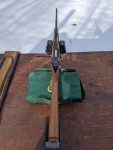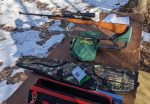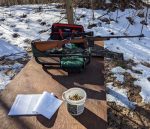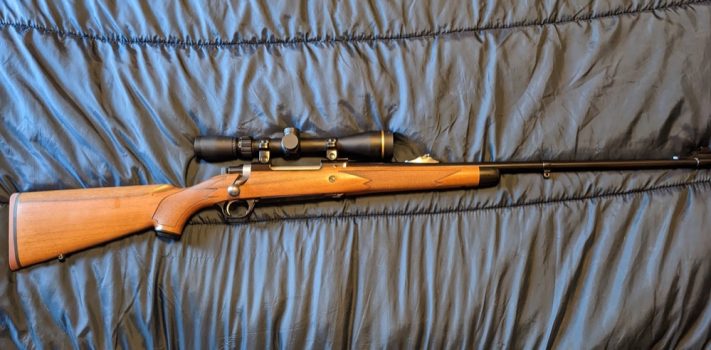A half-century ago, in the days of my youth, most rifles had wood furniture, blued steel, and iron sights. In those days of long ago, the 6.5x55mm Swedish cartridge had already had a long and storied career, having been first adopted in 1894 by the United Kingdoms of Sweden and Norway. In the years that followed, it was used to hunt elephants in Africa, to hunt moose in Scandinavia, and to resist the German invasion of Norway. The strengths of the cartridge were so significant, that it is prominently featured in the plot of Stephen Hunter’s novel, The Bullet Garden. The cartridge, used in a carefully selected Mauser Model 1896 rifle paired with a German 4X AJACK scope, constituted the Swedish m/41 sniper rifle system, which was the finest sniper rifle system of the World War II era.
The 6.5x55mm Swedish cartridge is still widely used around the world today, particularly in Scandinavia. I became interested in this classic cartridge after reading a number of fine articles and comments by SurvivalBlog contributor Tunnel Rabbit. These included the following:
∙ https://survivalblog.com/2021/03/05/long-range-game-part-1-tunnel-rabbit/
∙ https://survivalblog.com/2022/10/09/boers-beans-bullets-bear-soup-part-2-tunnel-rabbit/
∙ https://survivalblog.com/2022/11/18/choosing-practical-antique-rifle-part-2-tunnel-rabbit/
∙ https://survivalblog.com/2022/11/19/choosing-practical-antique-rifle-part-3-tunnel-rabbit/
∙ https://survivalblog.com/2022/11/20/choosing-practical-antique-rifle-part-4-tunnel-rabbit/
When I discovered that the Ruger M77 Hawkeye African was available in 6.5x55mm Swedish, I was eager to try it. I contacted Ruger, and they were kind enough to loan me a rifle for testing and evaluation.
Overview
I found the Ruger M77 Hawkeye African in 6.5x55mm Swedish to be a work of classic beauty, with checkered wood furniture, blued steel and iron sights. Testing was hampered by limited ammo selection. This rifle would best realize its full potential in the hands of a skillful reloader like Tunnel Rabbit. Those in the American market who are dependent on factory ammo would probably be better served by a rifle chambered in 6.5 Creedmoor, which has a much wider selection of ammo available.
First Impressions
The box that I picked up from my FFL contained the rifle, bolt, scope rings, a sling swivel for the front stock, a torx wrench for the scope rings, a cable lock, a Ruger sticker, a torque level card for various stocks and models of the M77, a ShopRuger.com discount card for registering a new firearm, a card for the Ruger “Old Model” Conversion (upgrade) Kit, a ShopRuger.com ad card, and the instruction manual.
The rifle itself embodies classic design elements that have stood the test of time. The nicely checkered walnut stock provides excellent grip surfaces. The shade of stain on the stock is a little lighter than I usually expect for walnut. The finish on the wood is not quite as rich, deep and glossy as I would associate with the sporting rifles of an earlier era. Although undeniably a commercial-grade finish, it is somewhat reminiscent of a military finish.
The recoil pad is thin and hard. It will absorb recoil better than a metal butt plate, but just barely. With the low recoil typical of the 6.5x55mm Swedish cartridge, this was not a significant issue.
The barrel and receiver sport a beautifully blued finish. The rifle comes with iron sights installed, which seems altogether fitting and proper.
The balance of the rifle is excellent, and the bolt operates smoothly. The excellent trigger consistently breaks crisply and cleanly.
The magazine holds four rounds. The floor plate opens using a latch on the trigger guard to allow the magazine to be emptied without cycling rounds through the chamber.
Integral scope mount bases are milled into the receiver. This means that there are no base screws that can wiggle loose and possibly contribute to inaccuracy. This also provides one less crevice in which moisture can collect and cause corrosion. I would love to see this brilliant design feature utilized by more rifles, although I would recommend Picatinny or Weaver rather than proprietary bases.
Reading the Manual
The manual is 40 pages long including the front and back covers. It begins with the usual boring state-by-state warnings that discourage people from reading any manual. That is unfortunate, because manuals typically contain a wealth of helpful information. Here are some highlights from this one:
∙ The adjustable LC6 trigger is made of steel.
∙ The 3-position safety can be placed in fire, load/unload, and safe positions.
∙ The manual incorrectly states that the rifle comes equipped with a muzzle brake. Although this is true of many M77 African models, it does not apply to this model chambered in 6.5X55mm Swedish.
∙ The rifle can discharge when dropped if the safety is off, even if the trigger is not pulled.
∙ It is necessary to remove only the bolt for a typical cleaning.
∙ The manual includes directions for disassembling and reassembling the bolt, stock, trigger, sear, and safety assemblies if necessary.
∙ The manual references online videos for the various procedures described in the manual, such as cleaning.
∙ The manual incorrectly states that the iron sights are not adjustable for elevation. Although this is true of many M77 African models, it does not apply to this model chambered in 6.5X55mm Swedish.
The First Range Session
It was a beautiful, sunny day in early February with a temperature of 34 degrees Fahrenheit. I put on some insulated canvas coveralls and a jeep cap, and headed to the improvised range behind my pole barn to do a preliminary zero on the iron sights.
 I set up targets in front of the backstop, and set up a table 25 yard away with a lead sled. I placed the rifle on the lead sled and chambered a single round of PPU Rifleline 139 grain FMJBT. I aimed at the center of the target and fired. Windage was excellent, but the elevation was about 4 inches low. Over the course of the next three rounds I gradually adjusted the sights up, until they were at maximum elevation. I was still hitting about 2 inches below my point of aim.
I set up targets in front of the backstop, and set up a table 25 yard away with a lead sled. I placed the rifle on the lead sled and chambered a single round of PPU Rifleline 139 grain FMJBT. I aimed at the center of the target and fired. Windage was excellent, but the elevation was about 4 inches low. Over the course of the next three rounds I gradually adjusted the sights up, until they were at maximum elevation. I was still hitting about 2 inches below my point of aim.
I concluded my initial range session with a 3-shot group that sized at .8 inches, which is not especially impressive at 25 yards. This was at least partly attributable to the fact that it was somewhat difficult for my aging eyes to acquire the iron sights.
 Throughout the range session, I noted that the trigger was great, the trigger guard easily accommodated a pair of light gloves, the bolt operated very smoothly, and recoil was virtually non-existent through the Lead Sled. Bolt lock up was solid, and the safety felt intuitive and operated smoothly.
Throughout the range session, I noted that the trigger was great, the trigger guard easily accommodated a pair of light gloves, the bolt operated very smoothly, and recoil was virtually non-existent through the Lead Sled. Bolt lock up was solid, and the safety felt intuitive and operated smoothly.
Cleaning following the range session was very simple and straightforward, as is common with most bolt-action rifles. It consisted of removing the bolt; running patches with solvent through the bore until they came out clean; using solvent to clean the bolt, chamber, and other accessible metal surfaces; running a dry patch through the bore and over all accessible metal surfaces to remove residual solvent; and using patches to apply CLP to the bore, bolt, chamber, and other accessible metal surfaces.
Mounting the Scope
 I mounted the bottom half of the sight rings directly to the bases machined into the receiver. I then placed a Leupold VX Freedom 3-9X40mm scope in the bottom half of the rings, and installed the top half of the rings over the scope. I needed to slide the scope as far back in the rings as possible in order to achieve the proper eye relief.
I mounted the bottom half of the sight rings directly to the bases machined into the receiver. I then placed a Leupold VX Freedom 3-9X40mm scope in the bottom half of the rings, and installed the top half of the rings over the scope. I needed to slide the scope as far back in the rings as possible in order to achieve the proper eye relief.
The crosshairs were well-focused. I then leveled the rifle and scope, and tightened the rings evenly.
The Second Range Session
 It was a beautiful, sunny day in mid-February. The temperature was 38 degrees Fahrenheit. There was little wind. I set up the targets, table, and lead sled, and then bore-sighted the scope. I next loaded a single round of PPU Rifleline 139 grain FMJBT, and fired. It struck .5 inches low and 1.25 inches left of the point of aim from 25 yards. I adjusted the scope and fired another single round. It hit almost dead center on the point of aim. I then fired a 3 shot group. It clustered around the center of the target. I was now ready for further testing at the 100-yard indoor range of the local Rod and Gun Club.
It was a beautiful, sunny day in mid-February. The temperature was 38 degrees Fahrenheit. There was little wind. I set up the targets, table, and lead sled, and then bore-sighted the scope. I next loaded a single round of PPU Rifleline 139 grain FMJBT, and fired. It struck .5 inches low and 1.25 inches left of the point of aim from 25 yards. I adjusted the scope and fired another single round. It hit almost dead center on the point of aim. I then fired a 3 shot group. It clustered around the center of the target. I was now ready for further testing at the 100-yard indoor range of the local Rod and Gun Club.
Finally, I cleaned the rifle in the same way that I did for the previous range session.
The Third Range Session
Four days later I made my way to the 100-yard indoor range of the local Rod and Gun Club. I began by firing a single round of PPU Rifleline 139 grain FMJBT to make sure that I was on paper. The round hit about 5.5 inches high and about 1.5 inches to the right of the point of aim.
I adjusted the sights and then fired several 3-shot groups. The groups averaged about 4.74 inches in size, which is not very good for 100 yards.
I then returned home and cleaned the rifle as previously.
Conclusions
Due to my local limited ammo selection, I was only able to test this rifle with one kind of ammo. It is likely that a wider variety of ammo would have produced tighter groups. Installing a cheek rest would have allowed a better cheek weld, also likely contributing to tighter groups.
Since 6.5 Creedmoor ammo is available on the American market in a wide variety of loadings, most American riflemen would probably be better served with a rifle utilizing that cartridge rather than a rifle firing the similar but less widely available 6.5x55mm Swedish. The best groups I have ever shot at short range were from a Ruger American Ranch Rifle chanbered in 7.62×39. Based on that experience, I hope to soon test a Ruger American Rifle chambered in 6.5 Creedmoor.
Disclaimer
Ruger was kind enough to loan me a M77 Hawkeye African in 6.5×55 Swedish for testing and evaluation in conjunction with the writing of this article. In 2021, they were also kind enough to loan me a Ruger American Ranch Rifle in 7.62X39. In 2020, Leupold was kind enough to provide me with a Leupold VX-Freedom 3-9X40mm Tri-MOA Scope. I tried not to let the kindness of Ruger and Leupold interfere with my objectivity in this review, and believe that I have succeeded. I did not receive any other financial or other inducement to mention any vendor, product, or service in this article.










